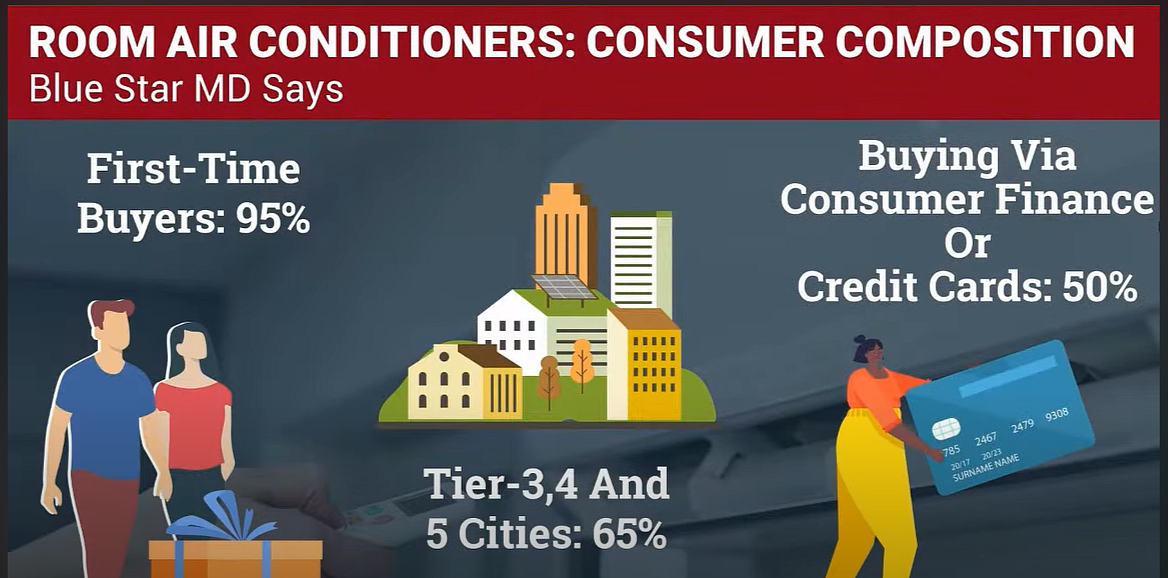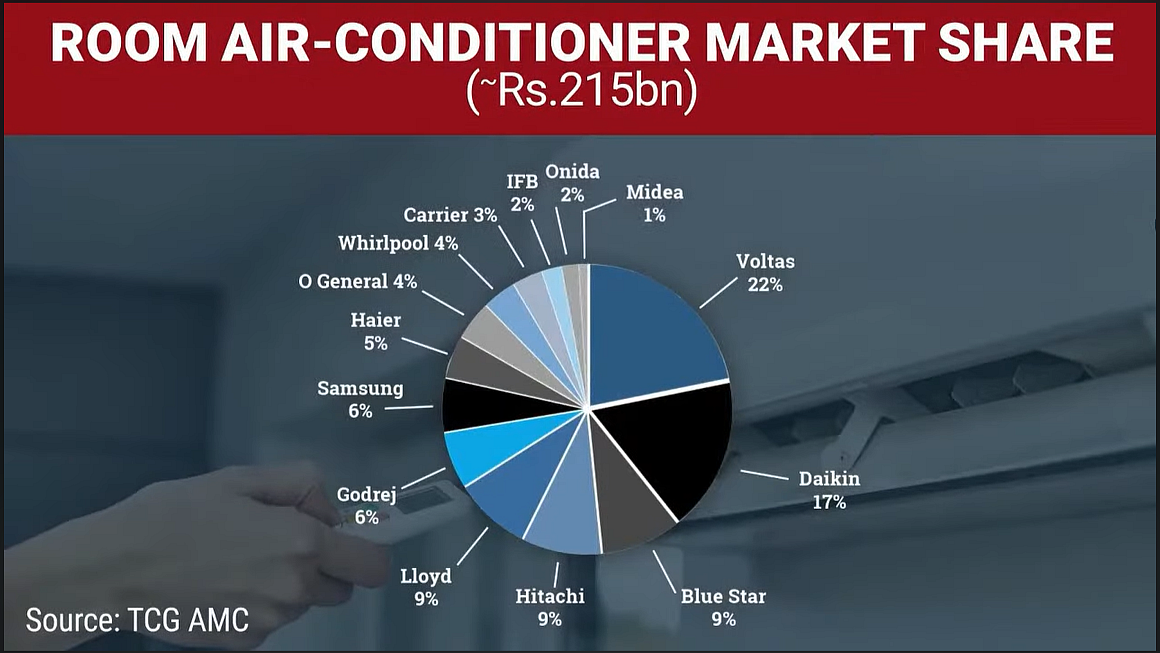India’s Air Conditioner Market Set To Turn Hot. And It's Not Just The Summer.
Air conditioners are likely to become more affordable with the government's production linked incentive scheme.

This is the second report in a multi-part series called ‘Insight’, where BQ Prime's Niraj Shah talks to some of the leading investors and companies on the outlook for a particular theme every week.
Air conditioners are likely to become more affordable with the government's production linked incentive scheme on all white goods and heightened infrastructure activity, according to industry leaders and experts.
"We are getting into a golden period, but a highly competitive period,” B Thiagarajan, managing director, Blue Star Ltd. told BQ Prime’s Niraj Shah when asked about his views on India’s AC industry in the next three to five years. “This is an exciting time. There are unmet needs and a lot of demand.”
The Indian summer, which has broken heat records multiple times over the past decade, has made air-conditioning an important fixture in Indian homes and offices. AC sales have nearly quadrupled since 2010 to nearly one crore units in 2022-23, according to data by Statista.
However, there’s still plenty of room to grow for makers of cooling solutions. That the government has banned imports of ready-to-install air-conditioners simply sweetens the pot. And the PLI scheme is simply the cherry on top.
Make In India, For The World
The government's PLI scheme is to be implemented between FY22 and FY 29, with a budgetary outlay of Rs 6,238 crore. The plan is to reduce the import of components— which makes up to 50% of the cost of an air-conditioner— by promoting local manufacturing.
“Barring compressors, I see India’s AC component ecosystem fully developed by next year,” Thiagarajan said. “Blue Star will look at investing in a compressor plant when we cross 1.5 million unit sales. Next year, we will cross one million and in another two to three years we should be [there].”
The PLI scheme can propel India’s AC market into a Rs 50,000 crore industry from Rs 20,000 crore, according to Chakri Lokapriya, chief executive officer, TCG Asset Management Ltd.
“The PLI scheme, which is aimed at reducing imports, will make the [local manufacturing] ecosystem stronger over time,” he said. “It is now up to the companies to make the most of the policies and execute well.”
According to Thiagarajan, the scheme will drive rapid growth in the next four to five years. “This can potentially double the AC manufacturing capacity [in the country] by next year.”
However, the incentive isn’t paid on production but on incremental sales. An applicant to the scheme will have to fulfill both the criteria of cumulative incremental investment in plant and machinery as well as incremental sales over the base year, to be eligible for the PLI.
“If I have to earn the PLI, I have to sell more,” Thiagarajan said. “The initial years are crucial because incentives (4-6% of incremental sales) reduce year after year.”
“So, what will happen is that manufacturers will dilute the PLI money from the pricing. So, as a consequence, the product will also become affordable to the end buyer. The companies, meanwhile, will improve their profits with the scale," he said.

Margin Levers
Is local manufacturing margin-accretive or a tool to lower prices, increased sales and capture of market share?
“If you are investing in manufacturing, remember there is an interest and depreciation burden as well,” Thiagarajan said. “Now you are attempting to replace China, which has the ability to manufacture at scale at a low price. You need innovation to get to that level. You have to service components locally in order to deliver the product matching that price.”
Blue Star has set itself a target to achieve 15% market share and 8-8.5% EBIT margin.
“We are very clear: we have to deliver profits and create shareholder value, and buying market share means nothing to us. I have to manage the market share as well as the return,” Thiagarajan said.

Revenue Mix
The post-pandemic boom in construction activity— from new offices to airports and data centres— has opened up the B2B stream of revenue for the cooling industry.
“Now, construction is a cyclical business...We are on a construction boom which is likely to last five to six years…Our own order book is driven by the manufacturing sector, where there is huge capex happening in airports, metro, railways and data centres,” the Blue Star MD said.
Then comes the business-to-consumer segment.
The room AC, for all intents and purposes, is a seasonal and an aspirational product in India. The addressable market— the aspirational middle class— is niche but still large at 30 crore or so. Most households still have only one unit, and replacements aren’t likely for seven to eight years.
An early summer does not necessarily translate into higher sales, either. A buyer, who may have planned a purchase in May, advances it to say late March, Thiagarajan said.
“For AC demand to go up, all it requires is 15-20 days of hot, summer nights,” he said. “A hotter summer or early summer creates demand in the sense that the room AC becomes a necessity, and may take precedence over buying, say a car that is still more aspirational.”
Against that backdrop, what does Blue Star’s revenue mix look like for the next five years? Will the commercial opportunity, which is large and untapped, outweigh the consumer?
"That’s a passionate subject of discussion within Blue Star," Thiagarajan said. According to him, it'll be one-third, one-third, one-third— B2B, B2C and international (exports).
Will Blue Star be able to maintain the 15% CAGR seen in the last decade on a high base effect even as new sales avenues open up?
Thiagarajan said that when the demand is high they will be able to improve the profitability and cash flows. "The question is not either-or because the room air-conditioner is a very large market and it is not cyclical in nature. It will continue to be consumed till such time India's penetration rate becomes 30 crore. Construction will come and go.”
Lokapriya believes India’s AC industry looks strong with Blue Star and its peers meeting most of the incoming demand. “I think the space itself is very exciting as the range of products expand, imports decrease, self-reliance [of India] increases, and as do the exports," he said.
The wider consumer goods market is also on the cusp of a boom period as spending power increases in the emerging economy.
"India will reach that inflection point probably a few years from now. When that happens, the consumption basket just barely takes off and that’s what makes the whole consumption basket very exciting,” Lokapriya said. “A company, which has a range of products, really stands to benefit.”